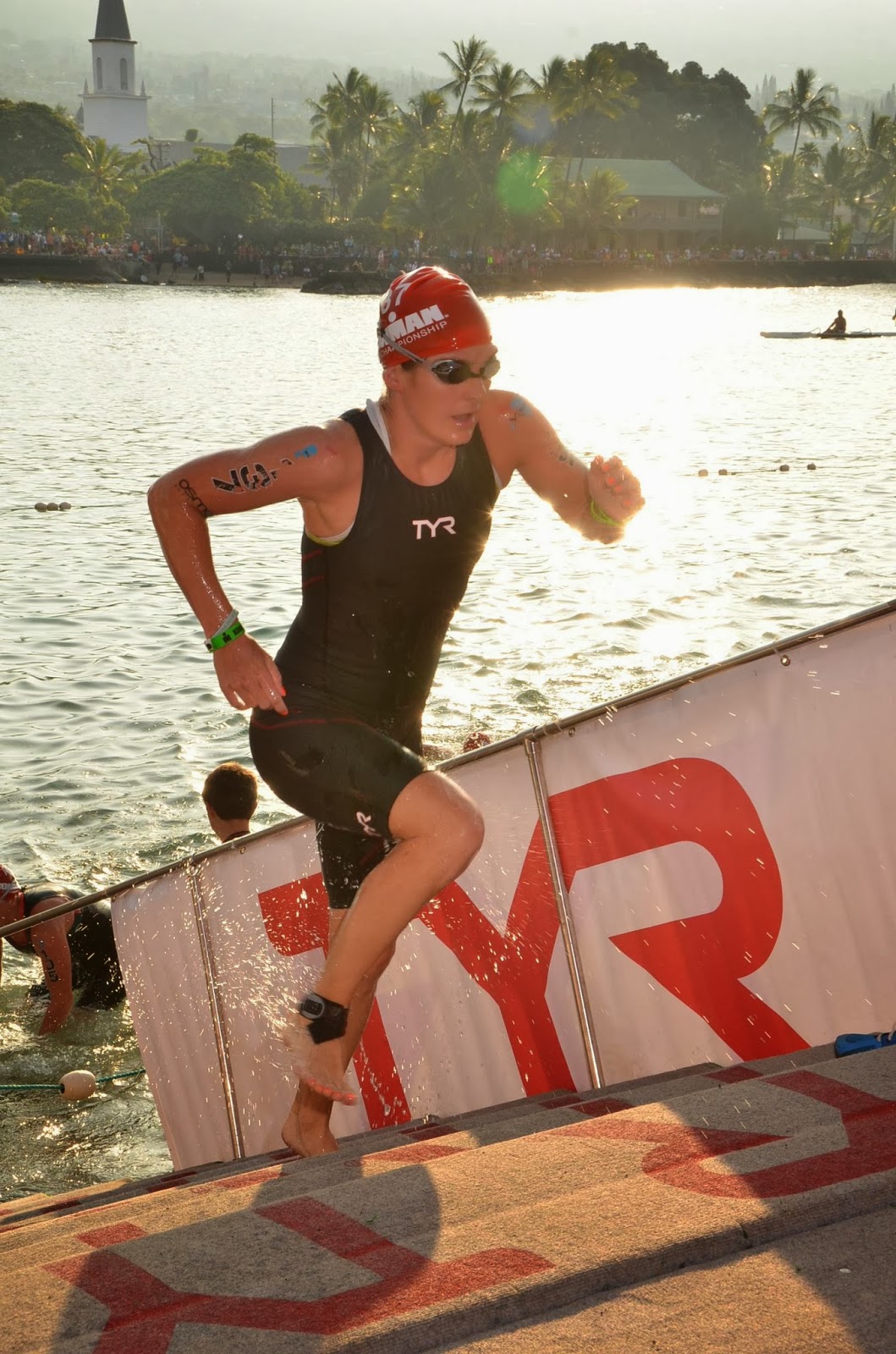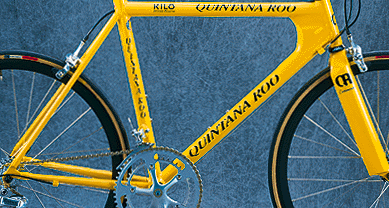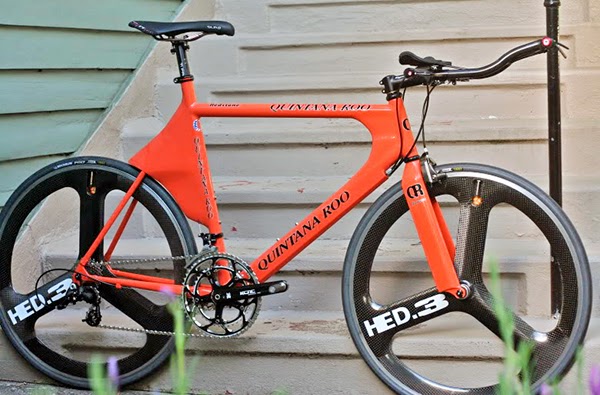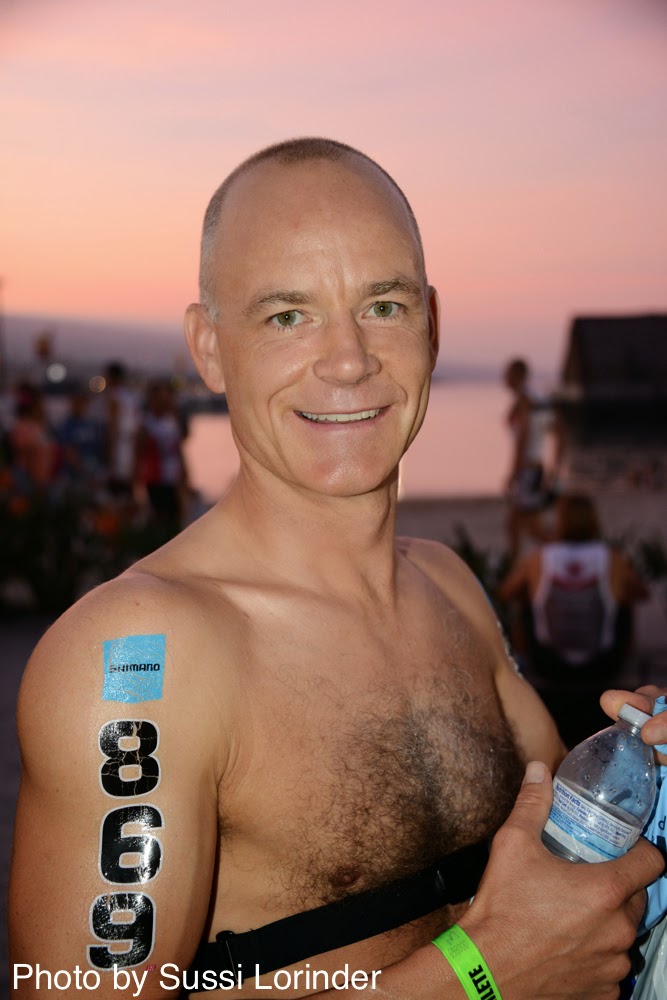Haley Chura has raced in the Olympic Trials for swimming in 2004 and 2008, owns several Ironman swim course records, won 70.3 New Orleans last year, was USAT Age Group National Champion in 2012, qualified for the Ironman World Championships in 2013, and for 2014, wants to earn her way back to Kona again. Find out why "It's Personal" for Haley.
Haley, can you tell a little bit about yourself? How is triathlon “Personal” for you?
Growing up, I always knew I would be a triathlete. My parents competed in the Bud Lite triathlon series during the 1980s and my first newspaper feature was a picture of me in my “racing stroller” at the 1988 Lilac Bloomsday Run in Spokane, Washington. My parents competed in triathlons, road races, trail races, and they even went open water swimming. As a kid, I truly believed those were the kinds of things all grown ups did.
When did you start doing triathlon?
![]() After graduating and wrapping up my college swimming career at the University of Georgia in 2007, I took a job at an accounting firm in Atlanta. Within my first month, the firm’s Managing Partner convinced me to run a marathon with him. I beat him by a minute. Luckily, instead of firing me, he decided our rematch should be a local half Ironman. The race was only a month before the 2008 Olympic Swim Trials and I think I trained more miles in the pool than on either the bike or run. I destroyed the swim field then watched nearly every person in the race pass me on the bike and run! The only person who didn’t catch me was my boss, so at least I was still a winner around the office!
After graduating and wrapping up my college swimming career at the University of Georgia in 2007, I took a job at an accounting firm in Atlanta. Within my first month, the firm’s Managing Partner convinced me to run a marathon with him. I beat him by a minute. Luckily, instead of firing me, he decided our rematch should be a local half Ironman. The race was only a month before the 2008 Olympic Swim Trials and I think I trained more miles in the pool than on either the bike or run. I destroyed the swim field then watched nearly every person in the race pass me on the bike and run! The only person who didn’t catch me was my boss, so at least I was still a winner around the office!
After that race my good friend Betty Janelle convinced me triathlon would be much less painful if I trained for the bike and run. With Betty’s guidance I hired Matthew Rose as my coach, joined the newly formed Dynamo Multisport team, and set out to do my first Ironman in 2009.
Why did you start doing triathlon?
I was happily retired from swimming for about 30 minutes before I missed it and knew I needed to do
something else. I felt I had reached my potential in swimming, but running and biking gave me new opportunities to grow. The distances and destinations of triathlon appealed to me, plus once I started meeting people I was hooked. It’s a very happy and healthy community and I love being a part of it.
![]() What have been some of your favorite races so far?
What have been some of your favorite races so far?
Hawaii will probably always be my favorite race. There’s so much tradition on that course and Kona is just a magical place. My first pro win was at the 2013 Ironman 70.3 New Orleans. Just two weeks before the race I left my accounting job to pursue triathlon full-time, so breaking the tape in Louis Armstrong Park was really emotional! I also love Ironman Brasil. That race feels like a laid back version of Hawaii. Floripa is a gorgeous race venue and I thought everyone in Brasil was super nice. I also made some really great friends on that trip.
What keeps you motivated?
Being relatively new to the pro ranks, I learn something every time I race. I love being able to celebrate small victories in both training and racing, but still know there’s so much room for improvement. I’ve also met some ridiculously great people through this sport and I being around good people makes me really happy.
What races do you have planned for this year?
I’m planning to kick off my year at Ironman Los Cabos at the end of March. After that I’ll likely race Ironman 70.3 New Orleans in April, then Ironman 70.3 St. Croix and Ironman Brasil in May. After Brasil I’ll probably evaluate the first half of the year and from there, I’ll make a plan of attack for the second.
![]() You were part of an NCAA national champion swim team and swam at the Olympic trials, you have several IM swim course records and in 2013 you were the first professional woman out of the water at Kona; how does that affect your race strategy?
You were part of an NCAA national champion swim team and swam at the Olympic trials, you have several IM swim course records and in 2013 you were the first professional woman out of the water at Kona; how does that affect your race strategy?
I think it means I’m the happiest person on the start line! My swim background gives me a lot of confidence, and not only for the swim portion of the race. I’ve had the honor of training with some of the best athletes and coaches in the world and everything they taught me continues to carry me through races today. I know what it takes to win in the pool, and I don’t believe open water and the open road are too different.
What does a typical day in the life of Haley Chura look like?
A normal day probably starts with lots of laughter and laps in the pool. I swim with the Dynamo Masters swim team and the group camaraderie makes every workout pure joy. After that I might hit the trainer or the road, depending on the time of year and duration/intensity of my bike workout. I do a lot of my running off the bike, so whether I have a 15 minute or 15 mile run, you can be sure my running shoes are nearby.
Is there anything else that you’d like to share?
My parents have taken a bit of a break from triathlon in recent years, but last week I got a very interesting text message from my mom that read, “I want to buy a Qunitana Roo.” I think 2014 could be a big triathlon year for the whole Chura family!
Be sure to check out haleychura.com, and don't forget to follow @haleychura on Twitter!
Growing up, I always knew I would be a triathlete. My parents competed in the Bud Lite triathlon series during the 1980s and my first newspaper feature was a picture of me in my “racing stroller” at the 1988 Lilac Bloomsday Run in Spokane, Washington. My parents competed in triathlons, road races, trail races, and they even went open water swimming. As a kid, I truly believed those were the kinds of things all grown ups did.
When did you start doing triathlon?
 After graduating and wrapping up my college swimming career at the University of Georgia in 2007, I took a job at an accounting firm in Atlanta. Within my first month, the firm’s Managing Partner convinced me to run a marathon with him. I beat him by a minute. Luckily, instead of firing me, he decided our rematch should be a local half Ironman. The race was only a month before the 2008 Olympic Swim Trials and I think I trained more miles in the pool than on either the bike or run. I destroyed the swim field then watched nearly every person in the race pass me on the bike and run! The only person who didn’t catch me was my boss, so at least I was still a winner around the office!
After graduating and wrapping up my college swimming career at the University of Georgia in 2007, I took a job at an accounting firm in Atlanta. Within my first month, the firm’s Managing Partner convinced me to run a marathon with him. I beat him by a minute. Luckily, instead of firing me, he decided our rematch should be a local half Ironman. The race was only a month before the 2008 Olympic Swim Trials and I think I trained more miles in the pool than on either the bike or run. I destroyed the swim field then watched nearly every person in the race pass me on the bike and run! The only person who didn’t catch me was my boss, so at least I was still a winner around the office!After that race my good friend Betty Janelle convinced me triathlon would be much less painful if I trained for the bike and run. With Betty’s guidance I hired Matthew Rose as my coach, joined the newly formed Dynamo Multisport team, and set out to do my first Ironman in 2009.
Why did you start doing triathlon?
I was happily retired from swimming for about 30 minutes before I missed it and knew I needed to do
something else. I felt I had reached my potential in swimming, but running and biking gave me new opportunities to grow. The distances and destinations of triathlon appealed to me, plus once I started meeting people I was hooked. It’s a very happy and healthy community and I love being a part of it.
 What have been some of your favorite races so far?
What have been some of your favorite races so far?Hawaii will probably always be my favorite race. There’s so much tradition on that course and Kona is just a magical place. My first pro win was at the 2013 Ironman 70.3 New Orleans. Just two weeks before the race I left my accounting job to pursue triathlon full-time, so breaking the tape in Louis Armstrong Park was really emotional! I also love Ironman Brasil. That race feels like a laid back version of Hawaii. Floripa is a gorgeous race venue and I thought everyone in Brasil was super nice. I also made some really great friends on that trip.
What keeps you motivated?
Being relatively new to the pro ranks, I learn something every time I race. I love being able to celebrate small victories in both training and racing, but still know there’s so much room for improvement. I’ve also met some ridiculously great people through this sport and I being around good people makes me really happy.
What races do you have planned for this year?
I’m planning to kick off my year at Ironman Los Cabos at the end of March. After that I’ll likely race Ironman 70.3 New Orleans in April, then Ironman 70.3 St. Croix and Ironman Brasil in May. After Brasil I’ll probably evaluate the first half of the year and from there, I’ll make a plan of attack for the second.
 You were part of an NCAA national champion swim team and swam at the Olympic trials, you have several IM swim course records and in 2013 you were the first professional woman out of the water at Kona; how does that affect your race strategy?
You were part of an NCAA national champion swim team and swam at the Olympic trials, you have several IM swim course records and in 2013 you were the first professional woman out of the water at Kona; how does that affect your race strategy?I think it means I’m the happiest person on the start line! My swim background gives me a lot of confidence, and not only for the swim portion of the race. I’ve had the honor of training with some of the best athletes and coaches in the world and everything they taught me continues to carry me through races today. I know what it takes to win in the pool, and I don’t believe open water and the open road are too different.
What does a typical day in the life of Haley Chura look like?
A normal day probably starts with lots of laughter and laps in the pool. I swim with the Dynamo Masters swim team and the group camaraderie makes every workout pure joy. After that I might hit the trainer or the road, depending on the time of year and duration/intensity of my bike workout. I do a lot of my running off the bike, so whether I have a 15 minute or 15 mile run, you can be sure my running shoes are nearby.
Is there anything else that you’d like to share?
My parents have taken a bit of a break from triathlon in recent years, but last week I got a very interesting text message from my mom that read, “I want to buy a Qunitana Roo.” I think 2014 could be a big triathlon year for the whole Chura family!
Be sure to check out haleychura.com, and don't forget to follow @haleychura on Twitter!

































+(1).jpg)
























.jpg)



















